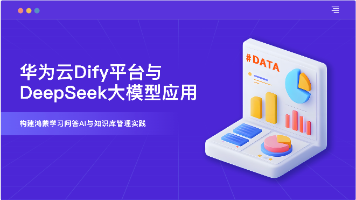在openHarmony开发板上开发deepseek的可视化应用(1.处理流式数据)
发送请求并监听实现数据转换,HTTPRequest.on('dataReceive',(...))订阅HTTP流式响应数据接收事件,HTTPRequest.on('dataEnd',(...))订阅HTTP流式响应数据接收完毕事件。通过上面JSON对象可以看出,response属性的值就是deepseek所生成的回答,而这种JSON数据是一个一个返回过来的,所以每当新的字符串返回来时,我们都需要及
目录
开发准备:
系统:open Harmony4.1
Api:Api11
前提:本地部署启动ollama
调用接口:http://localhost:11434/api/generate
开发步骤:
1.分析:
通过查看ollama文档我们可以得知返回的JSON数据会因为请求体中的stream的值不同而发生改变,请求体格式如下:
{
"model": "deepseek",
"prompt": "Why is the sky blue?",
"stream": false
}其中stream的值设为true时返回JSON对象流,如下:
{
"model": "deepseek",
"created_at": "2023-08-04T08:52:19.385406455-07:00",
"response": "The",
"done": false
}通过上面JSON对象可以看出,response属性的值就是deepseek所生成的回答,而这种JSON数据是一个一个返回过来的,所以每当新的字符串返回来时,我们都需要及时进行处理和渲染。而显然stream为true时,对于用户的体验感会更好。
而处理流式数据时,我们平时常用的HttpRequest.request网络请求方法是做不到的,而这时就需要把这个方法改为httpRequest.requestInStream.官方示例如下:
import http from '@ohos.net.http';
class Header {
public contentType: string;
constructor(contentType: string) {
this.contentType = contentType;
}
}
let httpRequest = http.createHttp();
let promise = httpRequest.requestInStream("EXAMPLE_URL", {
method: http.RequestMethod.GET,
connectTimeout: 60000,
readTimeout: 60000,
header: new Header('application/json')
});
promise.then((data: number) => {
console.info("requestInStream OK!" + data);
}).catch((err: Error) => {
console.info("requestInStream ERROR : err = " + JSON.stringify(err));
});
2.具体实现:
首先在ets目录下创建utils目录,将我们封装的http请求放在这里。

把http请求封装成一个PostStream函数,函数设置四个参数:
export function PostStream(
url:string, //数据地址
data:DataType,//请求数据
onChunkParsed: (parsedData: StreamResType) => void, // 每次解析到数据块时的回调
onChunkDone:(isDone:boolean)=>void // 数据传输完毕之后返回的回调
){
//....实现代码
}在PostStream函数体内创建http请求,设置请求参数:
// 创建 HTTP 请求对象
const httpRequest = http.createHttp();
// 设置请求参数
const options: http.HttpRequestOptions = {
method: http.RequestMethod.POST, // 请求方法
header: {
'Content-Type': 'application/json', // 请求头
},
extraData: data, // 请求体
readTimeout: 1200000000, // 读取超时时间
connectTimeout: 120000000, // 连接超时时间
};发送请求并监听实现数据转换,HTTPRequest.on('dataReceive',(...))订阅HTTP流式响应数据接收事件,HTTPRequest.on('dataEnd',(...))订阅HTTP流式响应数据接收完毕事件。在监听过程中我们需要将ArrayBuffer二进制数据转换为字符串,并通过buffer不断接受合并新的数据,从而达到不断更新回答的过程。最后当数据传递结束,将通过onChunkDone(true)的方式让结束信号返回从而更方便实现业务功能。
let buffer:string = ''//用于存储未解析的流式数据
// let receivedData:ArrayBuffer = new ArrayBuffer(0)//用于存储接收到的二进制数据
//监听数据传输
httpRequest.on('dataReceive', (chunk:ArrayBuffer) => {
console.info("ArrayBuffer",chunk)
//将二进制数据转换为字符串
const chunkString:string = String.fromCharCode(...new Uint8Array(chunk));
// console.info("转换为字符串"+chunkString)
buffer += chunkString
console.info("数据:"+JSON.stringify(chunkString))
onChunkParsed(JSON.parse(chunkString))
});
//数据传输结束
httpRequest.on('dataEnd', () => {
console.info('No more data in response, data receive end');
onChunkDone(true)
httpRequest.off('dataReceive');
httpRequest.off('dataEnd');
httpRequest.destroy()
});
// 发送请求
httpRequest.requestInStream(url, options).then((data) => {
console.info("requestInStream OK!");
httpRequest.off('headersReceive');
console.info("Data: "+JSON.stringify(data))
httpRequest.destroy();
}).catch((err: BusinessError) => {
console.info("requestInStream ERROR : " + JSON.stringify(err));
})3.数据类型:
//流式返回数据类型
export interface StreamResType{
model:string,
created_at: string,
response: string,
done: boolean,
}
//请求数据
export interface DataType{
model:string,
prompt:string,
stream:boolean
}4.调用:
PostStream('http://localhost:11434/api/generate', this.sendData, (res) => {
//...对返回的数据对象进行处理
},(isDone)=>{
if (isDone) {
//传输数据结束之后的处理
}
})更多推荐
 已为社区贡献3条内容
已为社区贡献3条内容









所有评论(0)